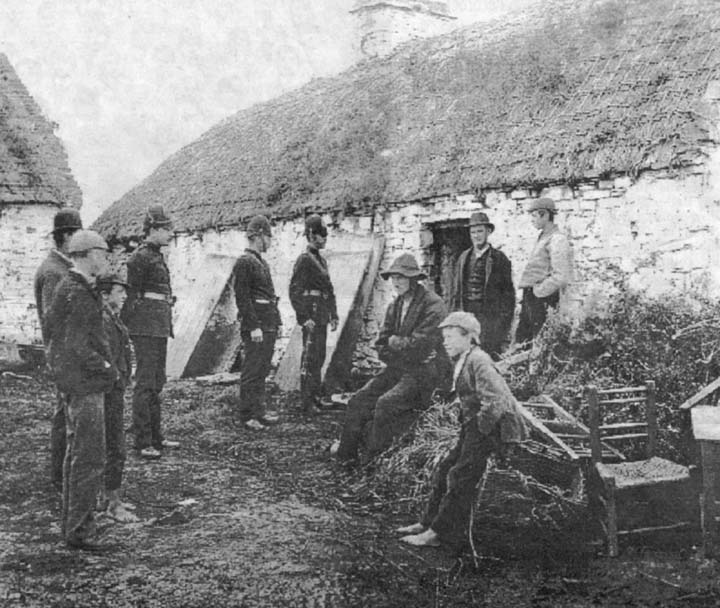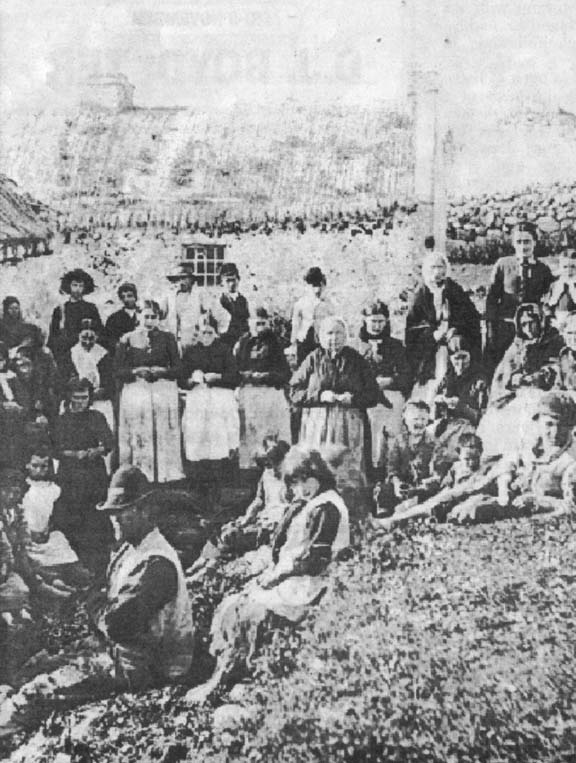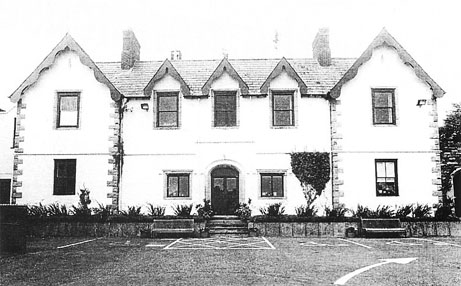|
The north of Ireland didn't suffer as badly from the Great famine as
did the south & south west of Ireland because they were sheltered
by the texile industry. But they still suffered and have been largely
ignored in the literature. Deaths in Belfast Workhouse rose from an
average of 300 per year to 1500 in 1847. Many fled to Glasgow, Scotland
(Irish News 11/10/2012 p35).
At the height of the Famine, an Ardglass man,
Michael Rush, sent the following anguished plea to his mother
and father in America:
"Now my dear father and mother, if you knew what hunger we and
our fellow countrymen are suffering, you would take us out of this poverty
Isle... if you don't endeavour to take us out of it, it will be the
first news you will hear by some friend of me and my little family to
be lost by hunger and there are thousands dread they will share the
same fate."
It is not known whether Michael Rush and his family survived the greatest
tragedy to befall Ireland. Between 1845-1850 the population of Ireland
fell from around eight million to about five million. As many as one
million died from hunger and disease. Another two million were forced
to emigrate.
Many died on the crowded 'coffin ships' which took the reluctant emigrants
across the Atlantic for a new life and a new start in America.
Unlike many counties, particularly in the west of Ireland where whole
communities were wiped out, County Down's population was not decimated.
But as Michael Rush's harrowing letter so vividly illustrates, there
was suffering and hardship on an enormous scale.
Starving C. Down families were forced to abandon their homes in the
countryside and seek refuge in overcrowded and disease- ridden workhouses
where death awaited many. Thousands more emigrated to America and other
English-speaking countries.
The Famine began in 1845 and was caused by a blight which attacked and
destroyed the potato crop, the main staple of Ireland's peasantry. The
potatoes rotted in the fields, leaving millions with nothing to eat
and unable to pay their yearly rents to the landlords. Relief measures
were introduced but when the crop failed the following year the crises
became a catastrophe.
The government initiated schemes to distribute food and provide work
for men. At a local level relief committees were set up through which
better off people did what they could. By the end of 1846 between thirty
and fifty Killyleagh women gave meals to the poor every day.
Numerous soup kitchens were being set up. The Kircubbin relief
committee handed out coarse bread with its soup, while in December 1846
the Killough committee purchased a boiler to help with its soup
making.
from 'Famine Relief Commission Papers, 1845-1847' kindly sent
by Vicki Baker.
National Archives #RLFC2/Z14002 (Original reference number: Z14002);
20/10/1845; Rev Joshua Free, Prependary of Dunsford, Ardglass,
submitting his proposal for the preservation of unsound potatoes, with
damp letter press copy acknowledgement.
#RLFC2/Z15328 (Original reference number: Z15328); 06/11/1845-11/11/1845;
Rev Joshua Free, Prependary of Dunsford, Ardglass, recommending
the extraction of starch from unsound potatoes in every workhouse throughout
the land and the manufacture of bread with potato flour. Includes printed
report on the potato disease by the Killultagh and Derryvolgie Farming
Society, with damp letter press copy acknowledgement.
# RLFC2/Z13038 (Original reference number: Z13038); 18/11/1845-19/11/1845;
Rev Joshua Free, Prebendary of Dunsford, Ardglass, enclosing
a return on the state of the potato crop within the parish, detailing
the level of intelligence of the respondent, an above or below average
crop, the proportion lost, the proportion expected to be lost, and preservation
measures.
In January 1847 a meeting was held to set up a soup kitchen in the Saul
area. The Down Recorder newspaper reported at the time: "Soup kitchens
are being established in several of the rural districts surrounding
Downpatrick to which the subscriptions from the landlords, proprietors
and tenant-farmers are very generous."
A month later the Down Recorder issued this update; "A soup kitchen
has been established at Saul, to which Lady Harriet Forde, with
her accustomed generosity has given money. A boiler has been fitted
in the school house. Soup is distributed twice a week to forty poor
persons."
One area which did not receive such benevolence
was Crossgar. By January 1847 there were, according to the Down
Recorder*," about 240 persons in this village in an utterly destitute
state and if something is not done for them the consequences will be
frightful. A benevolent gentleman in the neighbourhood made an effort
to establish a soup kitchen there, but in vain. He wrote to the proprietor
of the town and also to several owners of property adjacent, and just
two had the common civility to reply. Those two gentlemen, although
unconnected with the town of Crossgar, inclosed £5 each. The gentlemen
above alluded to, finding his efforts unavailing, returned the money
to the donors. The people, we are assured, are literally starving. Is
not this a melancholy state of things within five miles of the town
of Downpatrick? We implore the landed proprietors in the neighbourhhood
of Miserable place to apply to government, if they will not do anything
themselves and perhaps the Lord Lieutenant may give directions for the
establishment of a relief committee there, until Lord Russell's measure
come into operation, by which the destitute will receive out-door relief
under legal assessment. "
Those who made it to Downpatrick workhouse- the last resort for many-
were given food, but conditions were harsh. The workhouse was run by
the Board of Guardians whose policy was to make it as unattractive as
possible. But as the poor crowded in, fever could spread quickly. Emai
me for a photo of the Downpatrick Workhouse.
In March 1847, the matron, Miss McCreedy, died from the effects
of fever caught in the discharge of her duties. The Down Recorder noted;
" We had the pleasure of knowing Miss McCreedy since she
became matron and from the excellent state of discipline in which she
had the establishment, we can truly say that her loss there will be
severely felt."
Ironically, a month earlier, a committee had been set up to inquire
into the state of the workhouse's fever hospital, stated:" There
are at present under treatment about double the number of patients that
the building was originally calculated to accommodate. The store room
has been emptied of its contents and converted into a ward but a great
number of patients have to lie upon the floor, in the spaces between
the beds and what is still worse, in many cases, two patients in one
bed.
"We have a daily influx of patients and from the present condition
of the poorer classes and the prospect yet before them, we have every
reason to dread a continued increase in still greater proportion."
One feature of the famine was the harsh treatment meted out by landlords
to their tenants, who demanded their rent, famine or no famine. But
there were exception.
The Rev. W.B. Forde, of Seaforde, gave instructions that
no eviction notices would be served against his tenants. The Marquis
of Downshire who was an extensive landowner was praised for the "king
Treatment towards his tenantry on the Dundrum and Ballykinlar estates."
The effect of the famine in Co. Down can be seen from census records.
Between 1841 and 1851 Co. Down's population declined by almost 44,000.
Death and emigration were the chief causes.
In April 1849 the Down Recorder reported: " We observe, with regret,
that much of the wealth of this country is going to America and other
parts of the world. It is a bad sign for Ulster when the Down Peasantry
are leaving these shores. Within the last few weeks 2,000 people have
left Newtownards, Lecale and other parts of this county for emigration
to America with their talents and money." Few, if any, returned.
From Taste of Old Comber p58;
Comber suffered privation during the Great Famine . The Andrews family
imported large quantities of Indian corn, along with buckwheat peas
and beans from France and wheat from Egypt. The meal made from these,
however, was of such lamentable quality that not even the starving poor
would eat it, and so it had to be fed to the livestock. More substantial
help was provided in 1847 when some ladies set up a committee, selling
meal and coal at reduced prices and paying women and girls for knitting
and sewing. Eventually a soup kitchen was opened, supplying free bread
and soup to 230 families every day. Another 100 families could buy soup
for a halfpenny a quart. It cost over £30 a month to run the soup
kitchen, to which Lord Londonderry contributed £10."
Chronology of the famine
in Co. Down from The Down Recorder Newspaper:
Copies of these articles are obtainable from the South Eastern Library
& Information Service in Ballynahinch. seelb.localstudies@ni-libraries.net
1 Nov 1845: Article on the potato crop in Co Down* potato plague from
Holywood to Dundalk
8 Nov 1845: Meeting at Portaferry to discuss the potato crop
3 Oct 1846: Baronial meeting of landlords to discuss the need for employment
of labouring classes
3 Oct 1846: There were no ejectments on his several estates that year-
Rev W.B. Forde, Seaforde
17
Oct 1846: Famine relief meeting at Castlewellan- meeting
of landowners, gentry and clergy in the parishes of Kilmegan,
Drumgooland and Drumballyroney *
31 Oct 1846: Distress in Rathfriland*
31 Oct 1846: Saintfield Estate- a reduction in rents
9 Jan 1847: Several thousands attend famine relief meeting in Castlewellan
16 Jan 1847; Soup kitchens in Downpatrick & Killough
16 Jan 1847; reply re Lord de Ros stance on aid * (FCD)
21 Jan 1847; public meeting at Balle to discuss famine relief * (FCD)
30 Jan 1847; Destitution in Crossgar
39 Jan 1847: Soup kitchens in Saul * (FCD)
6 Feb 1847: Soup kitchen in Warrenpoint
6 Feb 1847; Bangor estate helps with funds * (FCD)
6 Feb 1847: Soup kitchen in Saul
6 Feb 1847: Famine relief meeting in Dunsford
13 Feb 1847; Famine Relief Committee meeting; Ardkeen soup kitchen
17 Feb 1847; report from Downpatrick Fever Hospital * (FCD)
20 Feb 1847: Saul soup kitchen * (FCD)
20 Feb 1847: Spread of fever in Downpatrick neighbourhood
26 Feb 1847; Meeting in parish of Knocbreda re Lord Downshire's aid
* (FCD)
6 Mar 1847; Ballee Famine Relief Fund notice
13 Mar 1847: Inch Famine Relief meeting
13 Mar 1847: Extension of public works to give employment to destitute
20
Mar 1847; Killinchy Famine Relief Committee report
20 Mar 1847; death of matron of Workhouse from fever * (FCD)
20
& 27 Mar 1847: Case of great destitution in Killinchy-in-the-Woods
10 Apr 1847: Famine Relief Meeting at Killyleagh
14 Apr 1849; emigration becuase of famine * (FCD)
1 May 1847: Appalling case; Ballydugan soup kitchen
1 May 1847: Famine Relief meeting at Annalong
15 May 1847: Crossgar Famine Relief meeting
22 May 1847: Ballee Famine Relief Fund notice
31 Jul 1847; Marquis of Downshire generous to his tenantry in Hillsborough
19 Aug 1847l Balle Relief Fund report* (FCD)
18 Sep 1847; Killough Famine Relief meeting
2 Oct 1847; Killinchy Famine Relief committee formed
27 May 1848: Marquis of Downshire's kind treatment to his tenants on
Dundrum & Ballykinlar estates
23 Dec 1848; report from Downpatrick Workhouse * (FCD)
14 Apr 1849; Emigration from Co Down ; 2000 people left for USA*
During this time lawlessness was reported with "agrarian outrages",
arson attacks, anti tractarian gatherings, Threshers & Repealers.
|


